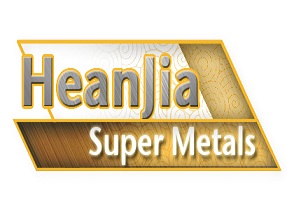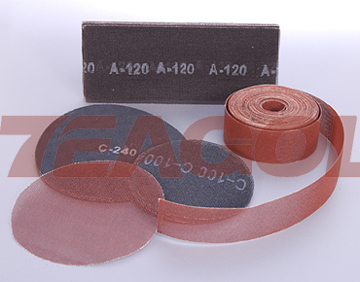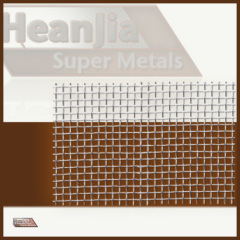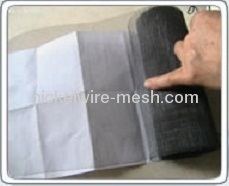
|
Heanjia Super-metals Co., Ltd.
|
Pure Tungsten Mesh for Optical material Coating
| Price: | 50.0~200.0 USD |
| Payment Terms: | T/T,L/C,D/A,D/P,WU |
| Place of Origin: | Hebei, China (Mainland) |
|
|
|
| Add to My Favorites | |
| HiSupplier Escrow |
Product Detail
Tungsten Mesh: Purity >99.9%, mesh thickness from 0.06mm to 4.0mm, high tensile strength and high melting point. Mesh finished in high quality.
Tungsten Mesh for Optical Material Coating
Mesh Weaving Method
Tungsten is the most widely used of the refractory metals. In wire form, it is essential for the production of lighting products such as wire filament, and other goods where its high temperature properties are of use. Among its properties are a melting point of 3410ºC, a low coefficient of thermal expansion and low vapor pressure at elevated temperatures, along with good electrical and thermal conductivity.
Tungsten Characteristics
1. Tungsten is a very hard, dense, silvery-white, lustrous metal that tarnishes in air, forming a protective oxide coating. In powder form tungsten is gray in color.
2. The metal has the highest melting point of all metals, and at temperatures over 1650 ºC also has the highest tensile strength. Pure tungsten is ductile, and tungsten wires, even of a very small diameter, have a very high tensile strength.
3. Tungsten is highly resistant to corrosion. It forms tungstic acid (H2WO4), or wolframic acid from the hydrated oxide (WO3) and its salts are called tungstates, or wolframates.
4. Tungsten is one of the five major refractory metals (metals with very high resistance to heat and wear). The other refractory metals are molybdenum, tantalum, rhenium and niobium.
Tungsten Applications
1. Tungsten as a high density material (19.3 g/cm3) for use in dynamic balancing, counterweights and flywheels.
2. Tungsten for radiation shields and x-ray targets.
3. Tungsten wire which is drawn into a fine filament for use in lighting, electronic devices and thermocouples.
4. Tungsten powders for chemical applications such as dyes, pigments, catalysts, cathode ray tubes and x-ray screens.
5. Tungsten as an additive for high temperature resistant alloy
6. For making supports and electron tubes
7. For aluminizing of chromo-scope & kinescope
8. Aluminum spraying, ceramic coating, metal, plastic
9. Vacuum metalized applicant
Chemical resistance
At relative humidity of under 60 %, tungsten is corrosion-resistant. In moister air, discoloration starts to occur. However, this is less pronounced than in molybdenum. Even at very high temperatures, glass melts, hydrogen, nitrogen, noble gases, metallic melts and oxide ceramic melts are largely unaggressive to tungsten provided that they do not also contain oxidants.
The table below indicates the corrosion resistance of tungsten. Unless indicated to the contrary, the specifications relate to pure solutions not mixed with air or nitrogen. Tiny concentrations of extraneous chemically active substances can significantly affect the corrosion resistance. Do you have any questions regarding complex corrosion-related topics? We would be delighted to help you with our experience and our in-house corrosion laboratory.
Physical properties
Tungsten has the highest melting point of all the refractory metals, a low coefficient of thermal expansion and a relatively high density. Tungsten's good electrical conductivity and excellent thermal conductivity are further valuable properties. The values of all these properties are higher for tungsten than they are in the case of molybdenum. Although it is in the same group in the periodic table, tungsten is located a period lower than molybdenum.
Mechanical properties
We optimize the purity of the material, determine the type and quantity of alloy components and modify the microstructure of our tungsten through heat treatment (annealing) and specially adapted forming processes. The result: customized mechanical properties for the most diverse applications. The mechanical properties of tungsten are similar to those of molybdenum. As in the case of molybdenum, these properties are dependent on the temperature at which they are tested. At 3 420 ºC, tungsten has the highest melting point of all metals. The material's high thermal stability coupled with its high modulus of elasticity give tungsten its high creep resistance.
Thermal Properties
Heat of Fusion | 35.2 kJ mol-1 |
Heat of Vaporization | 824.2 kJ mol-1 |
Heat of Atomization | 848.1 kJ mol-1 |
Mesh Weaving Method
Perforated Mesh |
Dutch Twill Weave Cloth |
Dutch Plain Weave |
Reverse Dutch Weave Cloth |
5-heddle Weave Mesh |
Cross twill weave |
The Service Part has more information about Mesh Form.
Special specifications can be produced by the customer's requirements.
Didn't find what you're looking for?
Post Buying Lead or contact
HiSupplier Customer Service Center
for help!
Related Search
Pure Tungsten
Pure Tungsten Electrode
Pure Epoxy Powder Coating
Mesh Material
Pure Nickel Wire Mesh
Pure Silver Mesh
More>>













